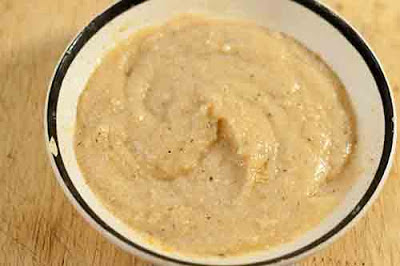The native Central Americans cultivated maize improving their strains in their regions in their way. When the grain is dried for storage it turns hard as pebbles and somewhat difficult to grind on their early shallow quern stones, primitive molcajetes. Thousands of these useful household implements ended up in museums across the world. Imagine the back aching time spent kneeling over these just for a handful of corn flour. It only takes a handful, 1/4 cup, for a whole bowlful of corn porridge or flat fried tortillas. It swells and thickens in boiled water.
They softened the gain by soaking the dry kernels in water and potash. How they discovered this nobody knows. Most likely by accident. Imagine it. Your resources are limited and you drop some precious hard won teosinte or later maize kernels into the fire embers. You lift them out and rinse off the ashes with water, and lo, the kernels are softer and easier to grind into powder to fashion your tortillas. The whole tribe takes up this practice of scooping up wood embers and dumping them into a clay pot of water and soaking their maize kernels, in alkaline solution actually, the result after milling is another world of workability, a new enhanced flavor, and ease of digestion
And so the tribes went minding their business with this method of processing for hundreds of years, then thousands of years, all the while improving their strains of maize and improving their technique of handling their milling, improving their molcajetes and naming their alkaline soaking process nixtamalization. Notice the word tamal in there?
Their maize spread to other native tribes farther North where climate gets really cold, but the practice of nixtamalization did not follow. The Northern tribes whose diet relied heavily on maize began suffering scoliosis, curvature of the spine, apparent in Northern native American burials. Not only does alkaline processing ease handling of grain and improve flavor it also makes nutrients in maize available that are not available to unprocessed maize.
Then white people showed up and picked up on this maize craze, with the knowledge of their Gregor Mendel and his work with peas and their grasp of the maize genome being so remarkably plastic they improved maize, now called corn in the country now called America, beyond their wildest dreams so far advanced that even modern Europeans have little realization of its splendor. To Europeans all maize is feed corn, a grain that they feed to their animals. Few appreciate what Americans know about the awesome bounty of sweetcorn.
Even Americans still do not process their corn with alkaline. If they did, corn would be much more digestible and considerably more healthful. But it wouldn't be as sweet. And it wouldn't be so fun to eat off the cob. And it wouldn't be the highlight of summer that it is.
Corn kernels soaked in alkaline solution then dried again are called posole.
It's also sold cooked in tins.
This can be ground just as popcorn kernels can be ground to powder by a home electric coffee mill for hominy grits. The powder will soak up 4X its mass of water. With butter, and spices, and whatever you like, say, cheese, jalapeños, onions, it's wonderful especially with eggs.
Theoretically this is masa harina, the stuff that corn tortillas are made of, and tamales.
Tonight I used this dry posole as corn meal is used to make cornbread. Except I enhanced my cornbread the usual ways as shown above and I cooked it first to better judge how much water the grain will take up. It tends to settle while cooking if you're not right there to stir it. I didn't want that happening with bread. But by adjusting for flour I ended up with too much for the bread pan so I fried the excess as pancakes as you do with corn fritters. These are corn fritters made with posole instead of fresh or tinned sweet corn. And I must say, they're among the best corn fritters I've tasted. Not so hot as intended, they're slathered with blackberry honey.
The most delicious miscalculation ever. This turned out to be dinner. And, man, those ancient native Central Americans back then sure would be impressed.













4 comments:
Potash, KOH, is celebrated throughout white American campers as KOA.
I kid.
The first thing the primitives discovered about fire ash was that it made cleaning their stoneware easier. If it softened the cooking dreck, why not the stuff cooked?
Romancing the Stone Age.
Potash, water and roundup ready.
Great post. Pozole soup has become one of my favs.
You call it corn, we call it maize...
Post a Comment